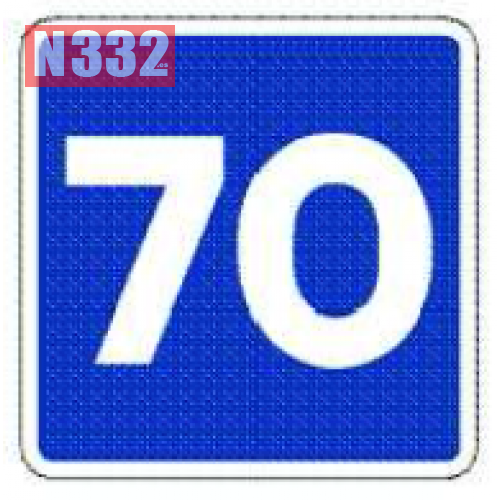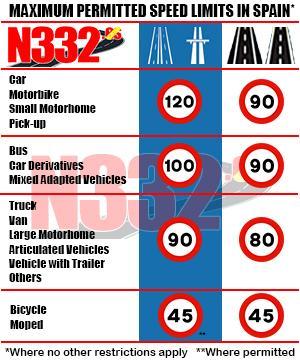Excessive or inappropriate speed is one of the three main contributing factors to road traffic collisions. In fact, in Spain, it is statistically as decisive risk factor in over 25% of all traffic incidents.
The risk factor increases along with the speed, which is further amplified by other factors such as the weather, driver inexperience or alcohol, subsequently increasing the risk further.
Roads are designed based on a number of different factors, and the maximum permitted speed decided on those characteristics. Sometime, it may not appear obvious as to why a reduction in the speed of a road may be required, but there is always a reason for this, and so the speed limit must be respected.
It is also important to remember that the speed limit indicates the maximum permitted speed during optimum conditions. It should never be treated as a target, but you vehicle´s speed should be adapted to reduce the risks to both yourself and other road users.
The maximum permitted speed on a road is indicated by means of a circular sign with a red border and the numbers in black the centre. This is a mandatory speed limit sign, known as R-301.

There is also a minimum required speed sign, the R-411, which is a blue circle with numbers in white in the centre. A minimum speed is a requirement on a number of roads, and so if your vehicle is incapable of reaching those speeds, you will not be allowed on them.

The third signs relating to speed are the S-7 and S-9, which is an advisory maximum speed limit sign. It is a blue square with white numbers printed in the centre and denotes the maximum speed which your vehicle should travel on through the stretch in question. The sign is advisory and not mandatory, but if road planners believe it important enough to warn drivers, then heeding their advice is always the best course of action.

These signs can also appear in conjunction with other information, such as denoting the minimum or maximum speed in a particular lane, such as the S-50.

There are also signs which denote the end of restrictions, but we will deal with those another time.
We have to remember though that the signs are not the only indicator to what we call “appropriate speed”. We must take into account all other factors such as the weather, flow of traffic, obstacles in the road, other road users and more. For example, on rainy days more incidents often occur because many drivers travel at the same speed as they do on a sunny day, not adjusting their speed to take the weather and road conditions into account.
Appropriate speed is never governed entirely by the maximum or minimum on the road, although it is likely to be somewhere in between, once we consider all of the other factors as well.
All roads have a speed limit, even those which don´t display speed limit signs.
Roads are separated into four main groups. The first group is toll roads and motorways, otherwise known as autopistas and autovias. The second group are conventional roads, which is split again into two subgroups, vías automóviles and carreteras convencionales with a hard shoulder equal to or greater than 1.5 m or more than two lanes for either direction (3 lanes or more in total); and other conventional roads, otras carreteras convencionales. The final group are urban roads, or Vías urbanas, travesías.
The table below indicates the maximum permitted speed under optimum conditions.

There are other restrictions on certain types of vehicles and activities which must also be taken into consideration, as you can see from the table above.
School buses have an enforced 10 kilometre per hour restriction when travelling above 50 kilometres per hour, so on a road where the limit is 90 km per hour, the maximum speed for school buses is 80, for example.
Buses carrying standing passengers with authorisation cannot exceed 80 kilometres per hour in any circumstance.
Vehicles transporting dangerous goods have a 10 km per hour reduced generic maximum speed on urban roads.
Any vehicle towing a trailer or caravan is subject to a reduction in the maximum permitted speed.
Motorways which pass through towns have an 80 km per hour restriction.
There are occasions when the maximum permitted speed can be exceeded for overtaking, but these are very rare conditions which are explained in a separate article.
With the vehicles surrounding us becoming increasingly advanced, the smoothness of the ride can lead to a false sense of security when it comes to speed. It is important to monitor your speedo at all times when driving, as it is easy to become complacent and not realise the speed which your vehicle is travelling.
As one of the main contributing factors to road traffic incidents, it is also one that we can control ourselves, and thus reduce the risks to everybody, making the roads safer for all.




You must be logged in to post a comment.